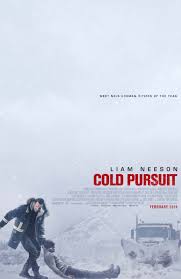Cold Pursuit
Posted on February 7, 2019 at 5:45 pm
B| Lowest Recommended Age: | Mature High Schooler |
| MPAA Rating: | Rated R for strong violence, drug material, and some language including sexual references |
| Profanity: | Strong language |
| Alcohol/ Drugs: | Drugs and drug dealing, alcohol |
| Violence/ Scariness: | Extended criminal peril and violence, many characters injured and killed, disturbing images |
| Diversity Issues: | Diverse characters |
| Date Released to Theaters: | February 8, 2019 |
| Date Released to DVD: | May 13, 2019 |
The setting of “Cold Pursuit” is white, not just the endless expanses of deep snow in the (fictional) ski resort town of Kehoe, Colorado. A frozen whiteness shimmers throughout the film, but the grim humor of the story is very, very dark.

Liam Neeson has been reliably providing us with annual winter action movies for more than a decade, starting with the “very special set of skills” rescue thriller Taken” in 2008. In that he was the father of a kidnapped daughter. This time, in a remake of the similarly snowy Norwegian film In Order of Disappearance, also directed by Hans Petter Moland, Neeson is the father of a murdered son.
He plays Nels Coxman (intentional — the Norwegian character’s name was Dickman), a snowplow driver who is about to be honored as the local community’s citizen of the year as the movie begins. He is a simple, straightforward man a bit disconcerted by the attention. When his wife (a criminally underused Laura Dern) gently reminds him that he will have to say a few words when he accepts the honor, all he can muster is, “I’m just a guy who keeps a strip of civilization open.” A man who has spent his entire clearing snow from one road recognizes the inevitably conflicted feelings about the road not taken, but is comfortable with the notion that “I picked a good road early and stayed on it.”
And then Nels and his wife are in the morgue identifying the body of their son, dead from a heroin overdose.” “Our son was not a druggie,” Nels says to the coroner. “That’s what all the parents say,” is the response. We have seen what happened and we know it was murder. We are here to watch Nels prove it, which happens quickly, and then to watch him avenge it, which takes some time. It isn’t enough for him to kill the men responsible. He has to go after everyone up the chain of command.
At the top of the chain of command is a brutal, arrogant man known as Viking (Tom Bateman), who gives his young son a copy of Lord of the Flies (“All the answers you will ever need”) and tells him he should have tried to fight the school bully. “A bully is a chance to prove your mettle.” The boy is not interested in fighting, or in the very restricted diet (no sugar, no junk food) his father insists on. Even the thugs on his father’s payroll take pity on him and slip him a few snacks.
As Nels knocks off one of Viking’s colorfully nicknamed henchmen after another, tombstone-like title cards appear to help us keep up. Because no one suspects an outsider, suspicion falls on Viking’s current and former colleagues, leading to many complications and much more killing. Soon there is another father seeking revenge. While the senior cop has no interest in anything but keeping the tourists happy, the rookie (Emmy Rossum) wants “to be able to tell the good guys from the bad guys.” And catch some bad guys, too.
The film is visually striking, the whiteness of the snow in the mountains echoed in the fur decor of a fancy ski resort, the merchandise in a bridal wear shop, the sterility of the morgue, with its agonizing cranking up of the drawer where the body is lying. The archness keeps us far enough away from the carnage to be amusing until there is so much of it we just get numb.
Parents should know that this is a very violent film with crime-related peril and violence, attempted suicide, shoot-outs, and disturbing and grisly images. The main character is essentially a serial killer, and the film includes drugs and drug dealing, sexual references, and very strong language.
Family discussion: What were the unintended consequences of Nels’ actions and how did he respond to them? How does this movie from most other action films?
If you like this, try: “Taken” and “Run All Night”







